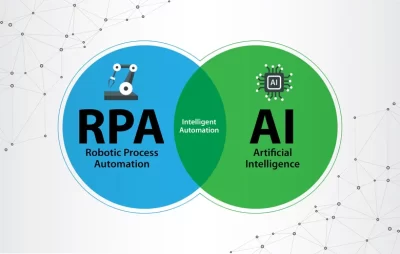
A Complete Guide To Automation And AI
AI Automation: Definition, Benefits, Applications, & More
Let’s see why automation and AI seem so much alike.
- Both perform tasks faster and save time.
- Both operate independently without human intervention.
- Both can replace and are replacing human roles.
Because of these similarities, one might think that AI and automation are essentially the same. But they are not. If you want to understand the fundamental difference between AI and automation and how they can be combined to achieve better results, first understand the term “automation”…
What is Automation?
What’s the first thing that comes to your mind when you hear the word “automation”? Something like “automatic”? That’s exactly what it is.
Automation is the use of technology to perform tasks without human intervention. It involves creating systems or processes that can operate independently to complete repetitive or complex activities, often leading to increased efficiency and accuracy.
According to Spiceworks, “Automation is the use of machines or technology to perform tasks without much human intervention.”
In simple terms, when a process traditionally performed by humans is carried out by technology, it is referred to as automation. Businesses use automation technology to reduce their expenses on manual labor (such as salaries), minimize human errors, and improve efficiency. Robotic arms assembling a car or online stores reminding you of your unordered shopping cart via emails are a few examples of automation.
Another common term related to automation is RPA, or Robotic Process Automation.
Robotic Process Automation (RPA)

Image Credit: https://www.softwebsolutions.com/resources/implementing-intelligent-automation.html
RPA is a specific form of automation that utilizes software robots (known as ‘bots’) to perform repetitive or routine tasks. Businesses employ these bots to save costs and allow their workforce to focus on more creative and complex tasks.
Is AI and Automation the same thing?
AI and automation can seem similar because both appear to replace humans in some capacity. However, there are key differences between them in terms of capabilities. Automation follows predetermined rules to conduct low-level tasks and involves no decision-making, primarily replacing unskilled labor by performing tasks faster and with fewer errors. On the other hand, AI possesses intelligence, enabling it to understand data and make decisions based on it. It is closer to human capabilities and can, to some extent, replace skilled labor.
To understand this better, let’s take the example of the healthcare sector: Automation handles manual tasks such as data entry, billing, patient monitoring, and sample processing. In contrast, AI performs tasks that require evaluation and decision-making, such as detecting fractures via X-ray images, suggesting treatment plans for patients based on their medical history, and verifying diagnoses and prescriptions provided by health professionals.
Intelligent Automation (IA): Combining AI with Automation
Intelligent automation, or AI automation, is an integrated version of automation (specifically RPA) and AI, along with Business Process Management (BPM). These three components work together as follows:
- AI acts as the brain of IA, making decisions based on its data.
- RPA performs specific, rule-based tasks within a business process using bots.
- BPM automates and optimizes the entire business process from end to end.
You can think of RPA and BPM as workers who perform physical labor, while AI acts as the engineer who instructs them.
Benefits of AI Automation
♠ Productivity: AI automation bots help save time as they can work faster and more efficiently than humans. They do not require breaks and can work non-stop.
♠ Cost Reduction: Traditionally, a business process would require multiple employees who needed to be paid a monthly salary. However, investing in AI automation can save those expenses in the long run.
♠ Error Reduction: Humans are bound to make mistakes, but that’s not the case with technology. AI automation can help reduce errors and improve the quality of work.
♠ Reduce Occupational Risks: AI automation can facilitate risky jobs and lower occupational hazards. For example, in the mining industry, miners face major health risks during excavation. Automated machinery can conduct risky excavations from a secure location while also monitoring air quality.
♠ Customer Experience: In almost all industries, AI automation is used to improve customer experience. AI chatbots, available 24/7, can easily solve general queries. If the customer is not satisfied with the bot’s response, it can direct them to a human representative from the suitable department.
Applications of AI Automation Across Various Industries
Healthcare
- Automation technology helps people book appointments, allowing them to schedule at their convenience with real-time availability updates and reminders to reduce cancellations.
- It speeds up diagnostic processes with higher accuracy. For example, Arterys, a cloud-based medical imaging software, detects heart-related abnormalities through MRI and CT scans.
- Patient monitoring systems like health watches detect abnormalities in heart rate, respiratory rate, oxygen levels, etc., and alert healthcare providers, aiding early disease detection.
- Robotic or robot-assisted surgery is known for its precision, performed through tiny incisions, causing less pain, blood loss, and resulting in less conspicuous scars.
Finance
- Banks and lenders use AI software to determine a person’s eligibility for a loan based on their financial history.
- AI chatbots act as first-level customer service providers, helping customers check their bank balance, view transaction history, schedule payments, and solve general queries quickly. Available 24/7, these chatbots can also provide personalized banking advice and offers.
- AI technology aids in fraud detection by learning from past fraudulent activities to detect future fraud and analyzing a person’s buying behavior to alert them about abnormal spending patterns.
Marketing and Advertising
- Email automation tools (like Convert Kit and Mailchimp) schedule emails to be sent at specific times, sequence emails for crash courses, and trigger emails based on customer behavior, such as transactional emails after a purchase or welcome emails after subscribing to a blog.
- AI automation assists in competitor analysis by collecting data about competitors’ ad strategies and generating insights.
- It analyzes customer behavior and recommends products to individuals who are likely to buy them.
Conclusion
Now you know that AI and automation are not the same and differ in their scope of abilities. However, they can be combined in the form of Intelligent Automation to gain the benefits of both. As the use of AI increases across businesses, many job roles will come to an end, while many new jobs will be created. Ultimately, the future will be determined by how well businesses and the general public adapt to the rise in AI and automation technology.


